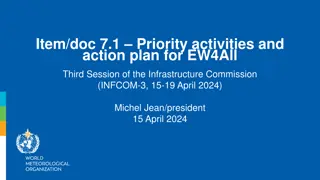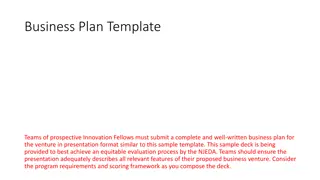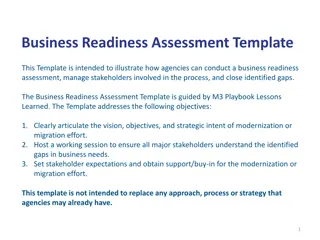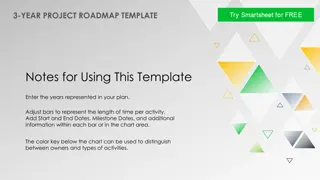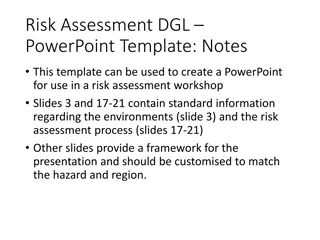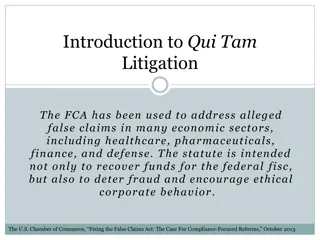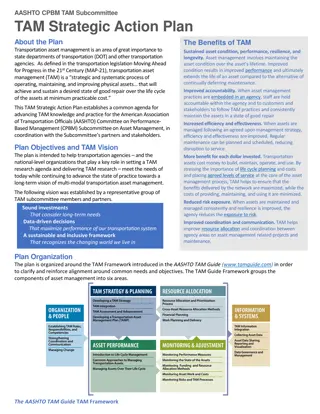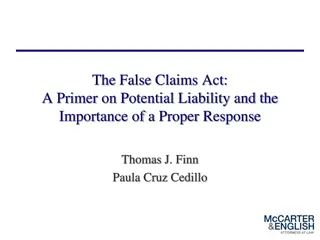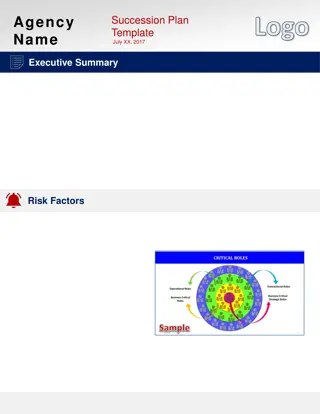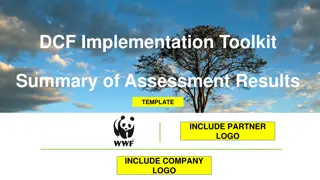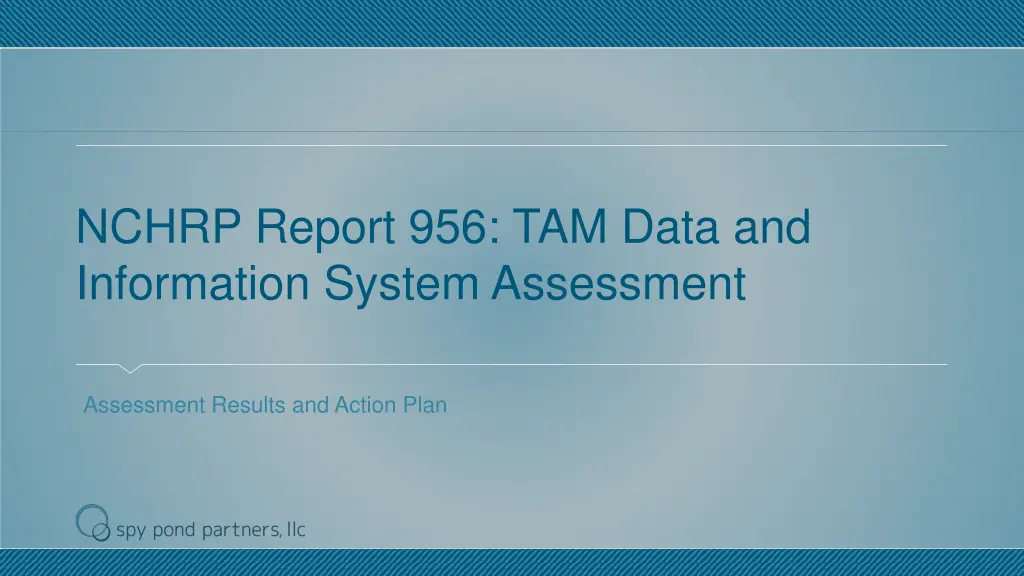
Effective TAM Data and Information System Assessment Results
Explore the outcomes of the NCHRP Project 08-115's Report 956 on Transportation Asset Management (TAM) Data and Information System Assessment. Gain insights into the assessment approach, key recommendations, and action plans for implementation. Access web-based tools and methodologies for self-assessment and improvement. Engage in assessing data collection, processing, and decision-support capabilities to enhance support systems. Join a diverse assessment team in evaluating opportunities for improving data processes and tools to optimize performance.
Download Presentation

Please find below an Image/Link to download the presentation.
The content on the website is provided AS IS for your information and personal use only. It may not be sold, licensed, or shared on other websites without obtaining consent from the author. If you encounter any issues during the download, it is possible that the publisher has removed the file from their server.
You are allowed to download the files provided on this website for personal or commercial use, subject to the condition that they are used lawfully. All files are the property of their respective owners.
The content on the website is provided AS IS for your information and personal use only. It may not be sold, licensed, or shared on other websites without obtaining consent from the author.
E N D
Presentation Transcript
NCHRP Report 956: TAM Data and Information System Assessment Assessment Results and Action Plan
Agenda Presentation Material: 1. Assessment Overview 2. Key Assessment Outcomes and Recommendations 3. Implementation Action Plans 2
Assessment Overview Approach-Specific Overview Approach-Specific Context by Assessment Area
TAM Data and Information System Assessment NCHRP Project 08-115: Report 956 Developed data self-assessment and improvement methodology and tools Guidance provided by NCHRP Report 956 Web-based version provided by AASHTO: www.tamdataguide.com AASHTO TAM Data Assistant A supporting, web-based tool provided by AASHTO: www.dataassessment.tam-portal.com 4
<Assessment Name> Assessment Context <describe targeted asset program, data area, or other context> Assessment Objective Benchmark current and desired data collection, processing, and decision-support capabilities Identify opportunities to improve supporting data, processes, and tools Document assessment outcomes and high-level action plan to support implementation 5
Assessment Team Core Team General Participants Consulted: <name, position> <name, position> <name, position> <name, position> Sponsor: <name, position> Subject Matter Experts: <name, position> <name, position> <name, position> Business Lead(s): <name, position> <name, position> Facilitator(s): <name, position> Field Representatives: <name, position> <name, position> <name, position> 6
High-Level Assessment Approach Kickoff Meeting Set scope, schedule, expectations (60 min) 1 Improvement Eval Core team consolidates improvements Improvement Evaluation Meeting (90 min) Discuss potential improvement priorities Evaluate potential organizational challenges Core team drafts assessment themes/actions 3 Benchmarking 2 Offline Individual Assessments Completed by <DD/MM> Action Planning Summary & Planning Meeting (60-90 min) Confirm assessment themes Explore proposed implementation actions 4 Group Assessment Meeting 1 (60-90 min) <Anticipated Discussion Areas/Topics> Group Assessment Meeting 2 (60-90 min) <Anticipated Discussion Areas/Topics> Closeout Assessment Closeout Meeting (60-90 min) Finalize plan, set responsibilities/timelines 5 Group Assessment Meeting 3 (60-90 min) <Anticipated Discussion Areas/Topics> Assessment Summary Materials finalized 7
Assessment Summary Area Overviews Key Themes
Area A: Specify and Standardize Data Area Description: Alignment of asset data req. & needs Standardization of data models for integration, analysis, and reporting Formalization of prioritization & allocation methodologies General Assessment Summary: <insert 1-3 key themes> General Improvement Recommendations: <insert 0-3 key improvements 9
Area B: Collect Data Area Description: Align/advance methods for collecting and assuring quality for key TAM related data General Assessment Summary: <insert 1-3 key themes> General Improvement Recommendations: <insert 0-3 key improvements 10
Area C: Store, Integrate, and Access Data Area Description: Manage data efficiently and integrate across asset lifecycle phases, processes, and systems General Assessment Summary: <insert 1-3 key themes> General Improvement Recommendations: <insert 0-3 key improvements 11
Area D: Analyze Data Area Description: Advance tools and practices for transforming raw data into information that can support TAM decision-making General Assessment Summary: <insert 1-3 key themes> General Improvement Recommendations: <insert 0-3 key improvements 12
Area E: Act on Data Area Description: Better incorporate data and information within TAM processes General Assessment Summary: <insert 1-3 key themes> General Improvement Recommendations: <insert 0-3 key improvements 13
Detailed Action Plan
Proposed Improvement Actions 1 <Insert proposed improvement name> <Insert General Improvement Grouping 1> 2 <Insert proposed improvement name> 3 <Insert proposed improvement name> <Insert General Improvement Grouping 2> 4 <Insert proposed improvement name> 5 <Insert proposed improvement name> <Insert General Improvement Grouping 3> 6 <Insert proposed improvement name> 7 <Insert proposed improvement name> 15
Action Plan Concepts Priority Relative priority for action (Low / Medium / High): What is most important to do first (or now)? Low hanging fruit or impact vs. effort? What can be accomplished with existing resources? Dependencies with other actions Implementation Lead Identifies who should lead the action Note: may be specific groups or individuals Benefit of Taking Action How the action will address an identified gap or achieve an identified business need Difficulty Relative level of effort (Low / Medium / High): Technical complexity of the action Required expertise or organizational capabilities Change management implications Impact to existing processes and stakeholders Status Proposed = envisioned, but not yet committed to execution Planned = committed to execution, but not yet underway In Progress = underway and not yet complete Complete = the activity has been completed 16
<insert general improvement grouping 1> Improvement # <Insert Proposed Improvement Name> Description: <insert description> Implementation Lead TBD Support: <insert supporting concepts or considerations> Benefit of Taking Action TBD <insert supporting concepts or considerations> <insert supporting concepts or considerations> Difficulty Status Priority TBD TBD TBD 17
<insert proposed improvement grouping 2> Improvement # <Insert Proposed Improvement Name> Description: <insert description> Implementation Lead TBD Support: <insert supporting concepts or considerations> Benefit of Taking Action TBD <insert supporting concepts or considerations> <insert supporting concepts or considerations> Difficulty Status Priority TBD TBD TBD 18
<insert proposed improvement grouping 3> Improvement # <Insert Proposed Improvement Name> Description: <insert description> Implementation Lead TBD Support: <insert supporting concepts or considerations> Benefit of Taking Action TBD <insert supporting concepts or considerations> <insert supporting concepts or considerations> Difficulty Status Priority TBD TBD TBD 19
Next Steps <Insert Next Step> <Insert Next Step> <Insert Next Step> 20
Contact information For more info, please contact: Thank you <insert contact name > <insert contact email> <insert contact name > <insert contact email>


